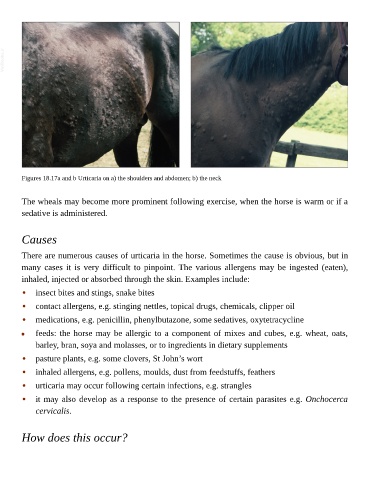Page 854 - The Veterinary Care of the Horse
P. 854
VetBooks.ir
Figures 18.17a and b Urticaria on a) the shoulders and abdomen; b) the neck
The wheals may become more prominent following exercise, when the horse is warm or if a
sedative is administered.
Causes
There are numerous causes of urticaria in the horse. Sometimes the cause is obvious, but in
many cases it is very difficult to pinpoint. The various allergens may be ingested (eaten),
inhaled, injected or absorbed through the skin. Examples include:
• insect bites and stings, snake bites
• contact allergens, e.g. stinging nettles, topical drugs, chemicals, clipper oil
• medications, e.g. penicillin, phenylbutazone, some sedatives, oxytetracycline
• feeds: the horse may be allergic to a component of mixes and cubes, e.g. wheat, oats,
barley, bran, soya and molasses, or to ingredients in dietary supplements
• pasture plants, e.g. some clovers, St John’s wort
• inhaled allergens, e.g. pollens, moulds, dust from feedstuffs, feathers
• urticaria may occur following certain infections, e.g. strangles
• it may also develop as a response to the presence of certain parasites e.g. Onchocerca
cervicalis.
How does this occur?

